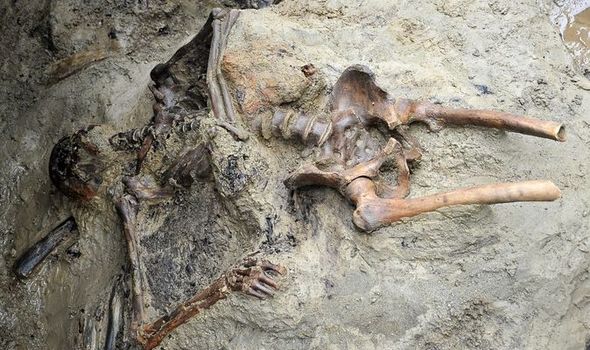The skeleton has been unearthed at Herculaneum.

The skeleton of a man killed by the deadly eruption of Mount Vesuvius almost 2,000 years ago has been unearthed from an ancient beach at Herculaneum — possibly as he ran in an attempt to escape the disaster.
The man was killed just steps from the sea in the ancient Roman town, which like Pompeii was destroyed by the colossal eruption of Vesuvius in A.D. 79.
Archaeologists think the man was running from the “boat sheds” in the town — actually stone arches used to store nets and fishing equipment — when he was overcome by the intensely hot “pyroclastic” cloud from the eruption that engulfed Herculaneum at a speed of more than 60 mph (100 km/h).
“When the pyroclastic cloud arrived, the temperature was above 500 degrees [Celsius, 930 degrees Fahrenheit] — it was very, very hot,” Francesco Sirano, the director of the Herculaneum Archaeological Park, told. “It was so hot that everything living was vaporized immediately, like this man.”
All that remains now are the man’s bones, which show he was facing away from the sea and toward the land when he fell on his back — presumably because he had turned to face the onrushing cloud of hot gas and volcanic debris, Sirano said. It’s thought the pyroclastic cloud then carried the body to the edge of the water along the ancient beach and maybe into the shallows, he said.
Ancient town
Herculaneum, on the Bay of Naples, was one of several Roman towns destroyed by the eruption of Vesuvius. Like the city of Pompeii, about 8 miles (13 kilometers) to the southeast, Herculaneum was covered by a layer of ash from the eruption that preserved it from both the elements and looting until it was rediscovered early in the 18th century.
Most of the dead found at Herculaneum — more than 300 people — were killed in the stone arches about 100 feet (30 meters) inland, where it’s thought they had taken shelter to await rescue from the sea when they were overcome by the pyroclastic cloud.
Writing about 25 years later, the Roman author Pliny the Younger stated that his uncle Pliny the Elder — a philosopher who was also the Roman admiral of the region — had ordered naval boats to Herculaneum to rescue people there from the eruption of Mount Vesuvius. The mission wasn’t successful, however, and the eruption killed Pliny the Elder at a town called Stabiae, a few miles south of Pompeii,
